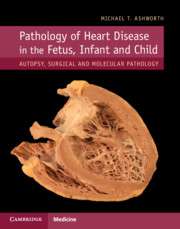Book contents
- Pathology of Heart Disease in the Fetus, Infant and Child
- Pathology of Heart Disease in the Fetus, Infant and Child
- Copyright page
- Dedication
- Contents
- Preface
- Chapter 1 The Anatomy of the Normal Heart
- Chapter 2 Examination of the Heart
- Chapter 3 Development of the Heart
- Chapter 4 Congenital Heart Disease (I)
- Chapter 5 Congenital Heart Disease (II)
- Chapter 6 Ischaemia and Infarction
- Chapter 7 Cardiomyopathy
- Chapter 8 Inflammation of the Myocardium, Endocardium and Aorta
- Chapter 9 The Coronary Arteries
- Chapter 10 Metabolic and Storage Disease
- Chapter 11 Pericardium
- Chapter 12 Fetal Cardiovascular Disease
- Chapter 13 Tumours
- Chapter 14 Heart Transplantation
- Chapter 15 Sudden Cardiac Death in the Young
- Index
- References
Chapter 1 - The Anatomy of the Normal Heart
Published online by Cambridge University Press: 19 August 2019
- Pathology of Heart Disease in the Fetus, Infant and Child
- Pathology of Heart Disease in the Fetus, Infant and Child
- Copyright page
- Dedication
- Contents
- Preface
- Chapter 1 The Anatomy of the Normal Heart
- Chapter 2 Examination of the Heart
- Chapter 3 Development of the Heart
- Chapter 4 Congenital Heart Disease (I)
- Chapter 5 Congenital Heart Disease (II)
- Chapter 6 Ischaemia and Infarction
- Chapter 7 Cardiomyopathy
- Chapter 8 Inflammation of the Myocardium, Endocardium and Aorta
- Chapter 9 The Coronary Arteries
- Chapter 10 Metabolic and Storage Disease
- Chapter 11 Pericardium
- Chapter 12 Fetal Cardiovascular Disease
- Chapter 13 Tumours
- Chapter 14 Heart Transplantation
- Chapter 15 Sudden Cardiac Death in the Young
- Index
- References
Summary
This chapter examines the structure of the normal heart at the gross, microscopic and ultrastructural levels. The pericardium, myocardium, endocardium, valves, arteries, veins, lymphatics, nerves and conduction system are described in detail, together with common variants of normal. References are given to normal values for heart measurements throughout gestation, infancy and childhood.
- Type
- Chapter
- Information
- Pathology of Heart Disease in the Fetus, Infant and ChildAutopsy, Surgical and Molecular Pathology, pp. 1 - 32Publisher: Cambridge University PressPrint publication year: 2019



